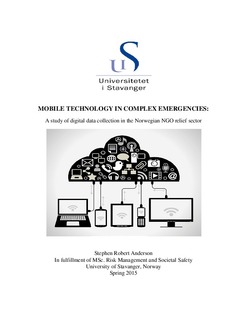| dc.description.abstract | This thesis presents a study of digital data collection amongst the five largest humanitarian relief organizations in Norway – with data from each actor. More specially, it examines the potentials and challenges in the implementation and diffusion of mobile technologies for the Norwegian NGO relief sector. The term mobile technology is used to describe the various mobile devices used for data collection including mobile phones, tablet computers, laptop computers, and so on. Within the confines of this study, social media was largely excluded.
In this thesis, an integrated diffusion/implementation model is presented and applied in the
analysis of how mobile technology spread (diffusion) and are applied (implementation). Integrated into this model, are components of sensemaking (ambiguity & uncertainty) and
different images of decision making in relief work. The purpose of this model is to explore and highlight the uses and experiences of mobile technology for data collection amongst the different organizations in presenting the matters of diffusion and implementation.
The findings suggest that mobile technology is a recognized humanitarian innovation that is diffusing within the Norwegian relief sector. Data collection is becoming faster, cheaper, more efficient, and is providing higher quality data with better oversight. At the same time, with the ease of data collection presents the challenges of data overload, competing solutions, administrative constraints and making sense of the data that is collected.
In conjunction with these findings, the thesis concludes that mobile technology is improving the efficiency for collecting information but is not a solution that is effective in all situations and all places. | nb_NO |

